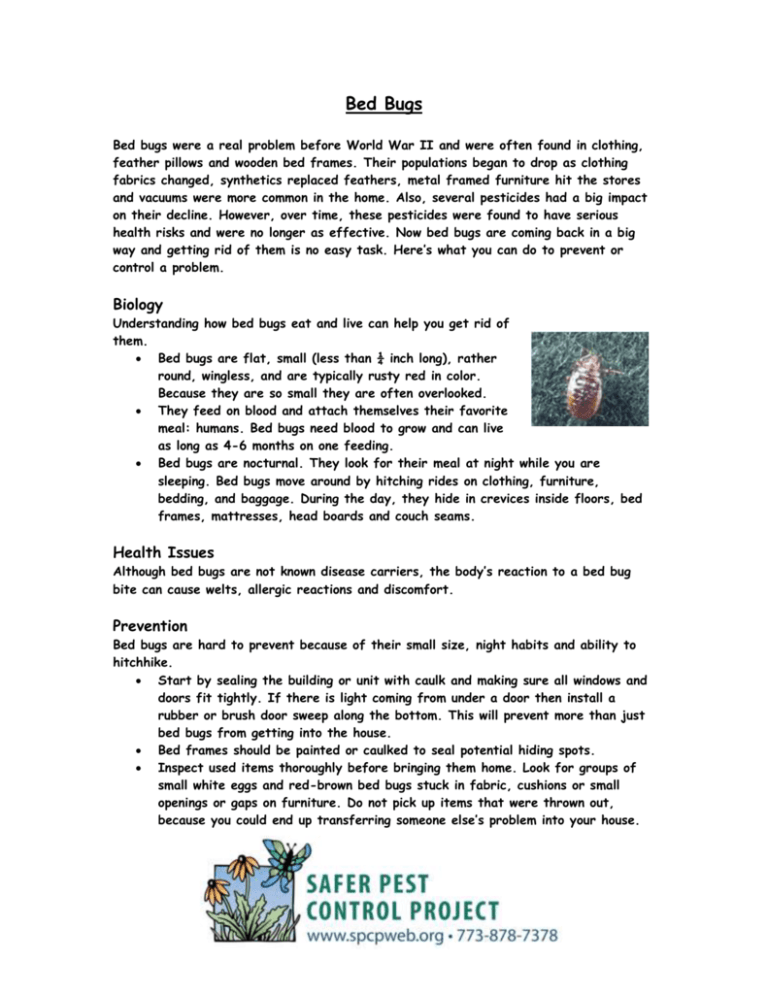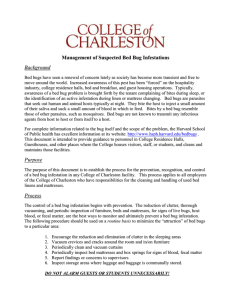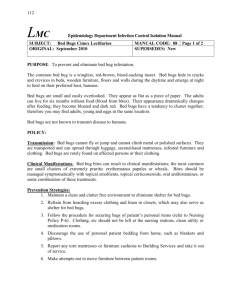Bed Bugs
advertisement

Bed Bugs Bed bugs were a real problem before World War II and were often found in clothing, feather pillows and wooden bed frames. Their populations began to drop as clothing fabrics changed, synthetics replaced feathers, metal framed furniture hit the stores and vacuums were more common in the home. Also, several pesticides had a big impact on their decline. However, over time, these pesticides were found to have serious health risks and were no longer as effective. Now bed bugs are coming back in a big way and getting rid of them is no easy task. Here’s what you can do to prevent or control a problem. Biology Understanding how bed bugs eat and live can help you get rid of them. Bed bugs are flat, small (less than ¼ inch long), rather round, wingless, and are typically rusty red in color. Because they are so small they are often overlooked. They feed on blood and attach themselves their favorite meal: humans. Bed bugs need blood to grow and can live as long as 4-6 months on one feeding. Bed bugs are nocturnal. They look for their meal at night while you are sleeping. Bed bugs move around by hitching rides on clothing, furniture, bedding, and baggage. During the day, they hide in crevices inside floors, bed frames, mattresses, head boards and couch seams. Health Issues Although bed bugs are not known disease carriers, the body’s reaction to a bed bug bite can cause welts, allergic reactions and discomfort. Prevention Bed bugs are hard to prevent because of their small size, night habits and ability to hitchhike. Start by sealing the building or unit with caulk and making sure all windows and doors fit tightly. If there is light coming from under a door then install a rubber or brush door sweep along the bottom. This will prevent more than just bed bugs from getting into the house. Bed frames should be painted or caulked to seal potential hiding spots. Inspect used items thoroughly before bringing them home. Look for groups of small white eggs and red-brown bed bugs stuck in fabric, cushions or small openings or gaps on furniture. Do not pick up items that were thrown out, because you could end up transferring someone else’s problem into your house. Control If bed bugs are in the house the best thing you can do is be persistent. This problem will require you to take many different steps over several weeks, but with patience you can succeed. First, find out where they are hiding. Bed bugs don’t just stay in mattresses though that is a favorite hiding spot. Carefully vacuum infested areas making sure to use the end of the wand to scrape the surface to remove eggs. Vacuuming alone will not eliminate the infestation. Furniture should be steam cleaned to kill remaining bugs and hidden eggs. Hand held steamers are now widely available in stores and will do a good job on both furniture and mattresses. Bed bugs can not survive temperatures above 97°F. After cleaning put a plastic cover over the mattress and, if possible, furniture. Covers need to be left on for at least 4 months. If the bed bugs are not hiding in or around the bed then move the bed out from any walls at least 12 inches. Do not let blankets or sheets that hang over the bed touch the floor. Wash all linen, laundry and other infested clothing articles in hot water then dry them at the highest possible setting. Sheets should be changed, washed and dried daily until bed bug biting has stopped and there are no more signs of infestation. Temperatures below 48°F will also kill them, so you may place infested articles in a cold location for at least 5 days. Get rid of unnecessary clutter from the floor, such as boxes and newspapers. You may have to throw out a mattress if the infestation is bad enough. Replacing it temporarily with a plastic air mattress can help a great deal If you have to throw any infested items item, please mark them in such a way that people will know not to pick them up and take them home. Otherwise, bed bugs will continue to show up in the community. Remember, even chemical treatments will require several visits to get rid of these difficult pests, and there is no magic bullet that will guarantee their elimination. In addition, pesticides should not be repeatedly used on furniture or mattresses where people sleep and relax. Pesticides can only harm what they touch, and unless used properly the only thing they will touch is you. Using the steps listed above is a great way to get rid of bed bugs and protect the health of your family.








